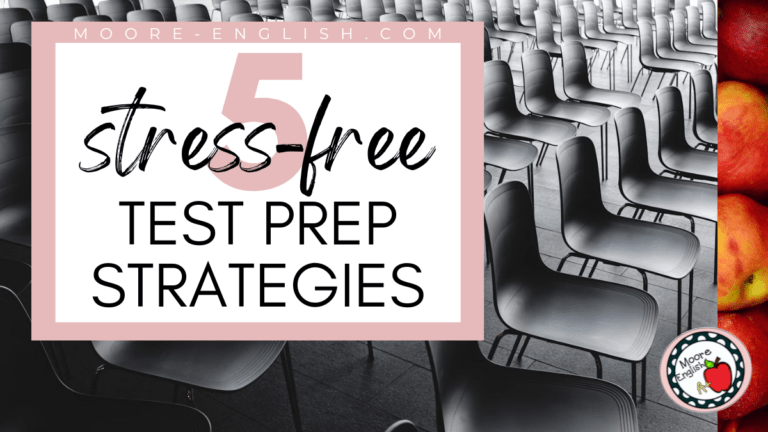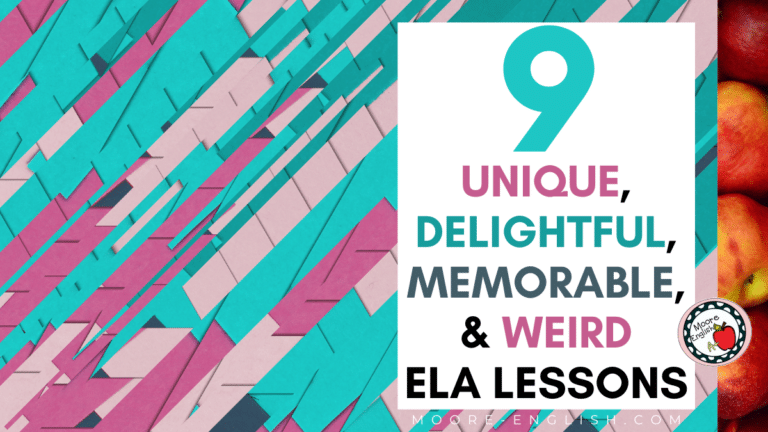Two weeks ago we talked about the 10 signs it’s time to find a new text to teach. Last week, we discussed 15 tools to make finding that text a little easier. But this week I want to talk about the steps involved in introducing a new text. How do you present a new text to students? And how do you prepare for that?
This post this post may contain affiliate links. Please read the Terms of Use.
Where are you going?
Backwards design tells teachers to begin with the end in mind. For this reason, when you approach a text, make sure you know where students are headed. What is it that students should know or be able to do by the time they finish interacting with this passage? Or, in the case of assessment, how will you use an excerpt to determine if students have reached the desired result?
Once you answer these questions, you can continue designing your instruction.
Read It
Students know when their teachers haven’t read the text. They know when you are a day or a page ahead. Before I read a text with students, I go through these steps:
- Anticipate student struggles: this often happens with unfamiliar words and implied historical or cultural context, for this reason, I also make sure to note tools provided to students such as text features, foot notes, captions, graphs, charts, etc.
- Write question or question stems: Coming up with questions on the spot often results in lower-level questions, so taking the time to prepare questions or question stems helps me assess student understanding at all levels.
- Note Text Moves: As I read, I note places where students should stop and do something. After this paragraph, students should make a prediction. At this point, students should be able to make this inference. Now students should stop and make a connection. This would be a good place for students to discuss a theme or Big Idea. Consider using these 4 strategies for nonfiction and informational texts.
- Reflect: Perhaps the most important thing I do before reading a text with students is make sure the text meets my instructional goals. For example, last year I read and annotated a selection from the textbook in anticipation of using it during Response to Intervention. My RtI group needed to focus on inference, but once I finished reading the excerpt, I realized I needed something else. It’s okay to reject a selection. It’s okay to slide it into your desk for a different lesson or a different skill. Don’t feel like you have to settle.
How will you package and present the new text?
Deciding how to package and present a new text has two key parts: text form and instructional strategy.
Text Form: How will students “meet” the text? Will they receive a paper copy? Or will students read digitally? Will students read independently, or will they listen to a recording? The answers to these questions often depend on my instructional goal and the needs of my learners. For example, if I have a class that gets distracted by technology, it’s not likely that we will read digitally. Instead, I am more likely to make copies. However, if I have a class that thrives on auditory instruction, it’s likely that we will listen to a recording.
Instructional Strategy: Choosing an instructional strategy helps teachers move students from the text to the desired result. So the question becomes: what strategy will help students reach the end goal? How do I get students from reading the text to doing this thing? In other words, learning is all about lightbulb moments. A text provides students with a lightbulb, and the desired result is the electricity that lights up the room. The instructional strategy you choose is the light switch. Check out these ideas for instructional design and reading strategies.
How will you follow up and build on the new text?
Letting a lightbulb burn out is the worst thing a teacher can do. So after you package and present a reading, build on the learning. Here are some options for building on learning:
- Task cards
- Collaborative Google Slides
- Short answers, journals, or Quick Writes
- Exit slips or other quick formative strategies
- Reading comprehension and analysis questions
- Socratic Seminars or other student-led discussions
- Student-generated reading and analysis questions
Epilogue: New Texts Are Needy
Finding a text and introducing it to students is one of the patterns of teaching ELA. But there’s a lot more involved in the process than you might think. What other steps should teachers take before introducing a new piece? Where else would you build on this process? Let us know in the comments.


Photo from Ivory Mix






